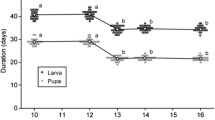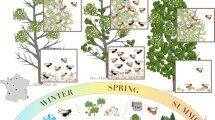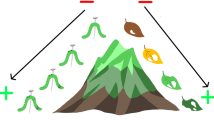Summary
We examined how an important plant mutualist (fungal mycorrhizae) interacted with a common tree parasite, a xylem-tapping mistletoe (Phoradendron juniperium Engelm.) growing on one-seeded juniper (Juniperus monosperma Engelm.). We also examined how host tree gender and environmental stress might be involved in this interaction. Four major patterns were observed. First, the mycorrhizal levels of trees of both sexes were negatively correlated with mistletoe density. In comparisons of heavily and lightly infested trees at the stressful site, high mistletoe levels were associated with 27% less mycorrhizae on male trees and 38% less mycorrhizae on the roots of female trees. Second, the reduction of mycorrhizae on trees with high mistletoe levels was slightly but significantly greater for female trees than male trees. These results are consistent with the hypothesis that severe mistletoe infestation suppresses mycoresis and that this suppression is more severe in female trees because of their greater energetic investment in reproduction. Third, female junipers growing in the stressful ash and cinder fields averaged three-fold higher levels of mistletoe infestation than male trees. Fourth, no differences in mistletoe infestation were observed between male and female trees growing in the more favorable soils. Comparisons with other systems suggest that both mistletoes and herbivores have similar interactions with mycorrhizae.
Similar content being viewed by others
References
Allen EB, Allen MF (1986) Water relations of xeric grasses in the field: interactions of mycorrhizas and competition. New Phytol 104:559–571
Armstrong JE, Irvine AK (1989) Flowering, sex ratios, pollen-ovule ratios, fruit set, and reproductive effort of a dioecious tree, Myristica insipida (Myristicaceae), in two different rain forest communities. Am J Bot 76:74–85
Bawa KS, Opler PA (1978) Why are pistillate inflorescences of Simarouba glauca eaten less than staminate inflorescences? Evolution 32:673–676
Bayne HG, Brown MS, Bethlenfalvay GJ (1984) Defoliation effects on mycorrhizal colonizaton, nitrogen fixation, and photosynthesis in the Glycine-Glomus-Rhizobiumsymbiosis. Physiol Plant 62:576–580
Bethlenfalvay GJ, Dakessian S (1984) Grazing effects on mycorrhizal colonization and floristic composition of the vegetation on a semiarid range in northern Nevada. J Range Manage 37:312–316
Bethlenfalvay GJ, Evans RA, Lesperance AL (1985) Mycorrhizal colonization of crested wheatgrass as influenced by grazing. Agron J 77:233–236
Bethlenfalvay GJ, Thomas RS, Dakessian S, Brown MS, Ames RN (1988) Mycorrhizae in stressed environments: effects on growth endophyte development, soil stability, and soil water. In: Whitehead EA, Hutchinson CF, Timmerman BN, Varady RG (eds) Arid lands today and tomorrow. Westview Press, Boulder, pp 1015–1029
Boecklen WJ, Price PW, Mopper S (1990) Sex and drugs and herbivores: sex-biased herbivory in arroyo willow (Salix lasiolepis). Ecology 71:581–588
Calder DM (1983) Mistletoes in focus: an introduction. In: Calder D, Bernhardt P (eds). The biology of mistletoes.Academic Press, Sydney, pp 1–18
Charnov EL (1982) The theory of sex allocation. Monographs in population biology 18. Princeton University Press, Princeton
Christensen KM, Whitham TG (1991) Indirect herbivore mediation of avian seed dispersal in pinyon pine. Ecology 72:534–542
Cline ML, Patrick Reid CP (1982) Seed source and mycorrhizal fungus effects on growth of containerized Pinus contorta and Pinus ponderosa seedlings. For Sci 28:237–250
Daft MJ, El-Giahmi AA (1978) Effect of arbuscular mycorrhiza on plant growth VIII. Effect of defoliation and light on selected hosts. New Phytol 80:365–372
Danell K, Elmqvist T, Ericson L, Salomonson A (1985) Sexuality in willows and preference by barkeating voles: defense or not? Oikos 44:82–90
Dawson TE, Ehleringer JR, Marshall JD (1991) Ecological correlates of seed mass variation in Phoradendron juniperinum, a xylem-tapping mistletoe. Oecologia 85:332–342
Dehne HW (1982) Interaction between vesicular-arbuscular mycorrhizal fungus and plant pathogens. Phytopathology 70:293–296
Ehleringer JR, Schulze E-D, Ziegler H, Lange OL, Farquhar GD, Cowan IR (1985) Xylem-tapping mistletoes: water or nutrient parasites? Science 227:1479–1481
Freeman DC, Klikoff LG, Harper KT (1976) Differential resource utilization by the sexes of dioecious plants. Science 193:597–599
Freeman DC, McArthur ED (1982) A comparison of twig water stress between males and females of six species of desert shrubs. Forest Sci 28:304–308
Gehring CA, Whitham TG (1991) Herbivore driven mycorrhizal mutualism in insect susceptible pinyon pine. Nature (London) 353:556–557
Giovanetti M, Mosse B (1980) An evaluation of techniques for measuring vesicular arbuscular mycorrhizal infection in roots. New Phytol 84:489–500
Grant MC, Mitton JB (1979) Elevational gradients in adult sex ratio and sexual differentiation in vegetative growth rates of Populus tremuloides Michx. Evolution 33:914–918
Hacskaylo E (1972) Mycorrhiza: the ultimate in reciprocal parasitism? Bio Science 22:577–583
Harley JL, Smith SE (1983) Mycorrhizal symbiosis. Academic Press, New York
Harper JL (1977) Population biology of plants. Academic Press, London
Hawksworth FG (1983) Mistletoes as forest parasites. In: Calder D, Bernhardt P (eds) The biology of mistletoes. Academic Press, Sydney, pp 317–333
Hikmat AAA, Strain BR, Mooney HA (1972) The physiological ecology of diverse populations of the desert shrub, Simmondsia chinensis. J Ecol 60:41–57
Hedgcock GG (1915) Notes on some diseases of trees in our national forests V. Phytopathology 5:175–181
Hull RJ, Leonard OA (1964) Physiological aspects of parasitism in mistletoes (Arceuthobium and Phoradendron) I. The carbohydrate nutrition of mistletoes. Pl Physiol 39:996–1007
Khanna SK, Viswanathan PN, Tewari CP, Krishman PS, Sanwal GG (1968) Biochemical aspects of parasitism by the angiosperm parasites: phenolics in parasites and hosts. Physiol Plant 21:949–959
Klopatek CC, Klopatek JM (1986) Mycorrhizae, microbes and nutrient cycling processes in pinyon-juniper systems.In:Everett RL (ed) Proceeding—pinyon-juniper conference, Intermountain Research Station, Ogden, pp 360–364
Knutson DM (1983) Physiology of mistletoe parasitism and disease responses in the host. In: Calder D, Bernhardt P (eds). The biology of mistletoes. Academic Press, Sydney. pp 295–316
Kormanik PP, McGraw A-C (1982) Quantification of vesicular-arbuscular mycorrhizae in plant roots. In: Schenck NC (ed). Methods and principles of mycorrhizal research. American Phytopathological Society, St. Paul, pp 37–46
Last FT, Wilson J, Mason PA (1990) Numbers of mycorrhizas and the growth of Picea sitchensis—what is the relationship. Agric Ecosyst Environ 28:293–298
Lee JA (1981) Variation in the infection of Silene dioica (L.) Clairv. by Ustilago violacea (Pers.) Fuckel in north west England. New Phytol 87:81–89
Lloyd D, Webb C (1977) Secondary sex characters in plants. Botanical Review 17:177–216
Lovett Doust J, Lovett Doust L (1985) Sex ratios, clonal growth and herbivory in Rumex acetosella. In: White J (ed). Studies on plant demography: a festschrift for John Harper. Academic Press, London, pp 327–339
Marshall JD, Ehleringer JR (1990) Are xylem-tapping mistletoes partially heterotrophic? Oecologia 84:244–248
McDougall WB, Jacobs MC (1927) Tree mycorrhizas from the central Rocky Mountain region. Am J Bot 14:258–267
McDougall WB (1973) Seed plants of northern Arizona. Museum of Northern Arizona, Flagstaff
McGonigle TP (1988) A numerical analysis of published field trials with vesicular-arbuscular mycorrhizal fungi. Funct Ecol 2:473–478
Meyer FH (1973) Distribution of ectomycorrhizae in native and man-made forests. In: Marks GC, Kozlowski TT(eds). Ectomycorrhizae: their ecology and physiology. Academic Press, New York, pp 79–106
Mopper S, Whitham TG, Price PW (1990) Plant phenotype and interspecific competition between insects determine sawfly performance and density. Ecology 71:2135–2144
Mopper S, Mitton JB, Whitham TG, Cobb NS, Christensen KM (1991) Genetic differentiation and heterozygosity in pinyon pine associated with resistance to herbivory and environmental stress. Evolution 45:989–999
Mopper S, Whitham TG (1992) The plant stress paradox: effects on pinyon sawfly sex ratios and fecundites. Ecology (in press)
Newman EI, Reddell P (1987) The distribution of mycorrhizas among families of vascular plants. New Phytol 106:745–751
Putwain PD, Harper JL (1972) Studies in the dynamics of plant populations V. Mechanisms governing the sex ratios in Rumex acetosa and Rumex acetosella. J Ecol 60:113–129
Read DJ (1991) Mycorrhizas in ecosystems. Experientia 47:376–390
Reinsvold RJ, Reeves FB (1986) The mycorrhizae of Juniperus osteosperma: identity of the vesicular-arbuscular mycorrhizal symbiont, and resynthesis of VA mycorrhizae. Mycologia 78:108–103
Sanders FE, Tinker PB, Black RR, Palmerly SM (1977) The development of endomycorrhizal root systems. I. Spread of infection and growth-promoting effects with four species of vesicular-arbuscular mycorrhizae. New Phytol 78:257–268
Stark N (1970) Water balance of some warm desert plants in a wet year. J Hydrol 10:113–126
Stribley DP, Tinker PB, Rayner JH (1980) Relation of internal phosphorous concentration and plant weight in plants infected by vesicular-arbuscular mycorrhizas. New Phytol 86:261–266
Tinker PBH (1975) Effects of vesicular-arbuscular mycorrhizas on higher plants. Symp Soc Exp Biol 29:325–349
Tinker PBH (1984) The role of microorganisms in mediating and facilitating the uptake of plant nutrients from soil. Plant Soil 76:77–91
Trent JD, Wallace LL, Svejcar TJ, Christiansen S (1988) Effect of grazing on growth, carbohydrate pools, and mycorrhizae in winter wheat. Can J Plant Sci 68:115–120
Vasek F (1966) The distribution and taxonomy of the western junipers. Brittonia 18:350–372
White TCR (1969) An index to measure weather-induced stress of trees associated with outbreaks of psyllids in Australia. Ecology 50:905–909
White TCR (1976) Weather, food and plagues of locusts. Oecologia 22:119–134
Zar JH (1984) Biostatistical analysis. Prentice-Hall, Englewood Cliffs
Author information
Authors and Affiliations
Rights and permissions
About this article
Cite this article
Gehring, C.A., Whitham, T.G. Reduced mycorrhizae on Juniperus monosperma with mistletoe: the influence of environmental stress and tree gender on a plant parasite and a plant-fungal mutualism. Oecologia 89, 298–303 (1992). https://doi.org/10.1007/BF00317231
Received:
Accepted:
Issue Date:
DOI: https://doi.org/10.1007/BF00317231




